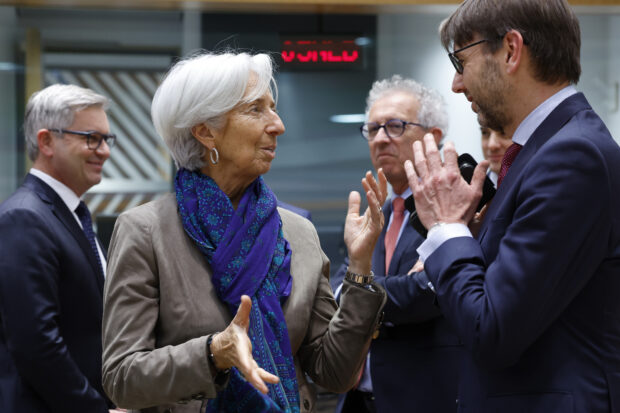Cutting interest rates too soon in Europe risks progress against inflation

European Central Bank President Christine Lagarde, left, speaks with Netherland’s Finance Minister Steven Van Weyenberg during a roundtable meeting of eurogroup finance ministers at the European Council building in Brussels, Monday, Jan. 15, 2024. Eurogroup finance ministers on Monday will discuss, among other issues, competitiveness, energy prices and the 2024 work program. (AP Photo/Geert Vanden Wijngaert)
FRANKFURT, Germany — Cutting interest rates too soon could threaten Europe’s progress in battling the inflation that has ravaged the economy, the head of the European Central Bank said Wednesday amid widespread speculation that the bank soon will lower rates from record highs.
Christine Lagarde, faced with market expectations for rate cuts as soon as March or April and a bank meeting next week, underlined the ECB’s intent to keep its benchmark rate high for “as long as necessary” until it’s clear that inflation is back to the goal of 2 percent.
Speaking at a Bloomberg News event during the World Economic Forum’s annual meeting in Davos, Switzerland, she acknowledged concerns the bank had gone too high too fast with borrowing costs.
“I know some people argue that maybe we are overshooting, maybe we’re taking risks,” Lagarde said.
But the bigger risk would be letting inflation get loose again and have to launch rate hikes again, she said.
Speculation that central banks including the ECB and the U.S. Federal Reserve are about to start cutting rates helped spark a surge in stock market indexes over the last weeks of 2023.
READ: Markets outpace central banks as rate cut bets fuel ‘everything rally’
Lower rates boost business activity and can make conservative holdings such as bank deposits less attractive compared with riskier stocks. Stock prices have eased somewhat this year as the initial enthusiasm about possibly lower rates has faded and was tempered by worries about weak economic growth and geopolitical disruption such as the Israel-Hamas war.
Recent comments from senior Fed officials suggest that the central bank remains on track to begin cutting its key rate likely by midyear. In December, Fed policymakers collectively forecast that they would cut their rate three times this year. Wall Street investors and many economists expect the first cut in March.
Inflation in Europe has fallen from a peak of 10.6 percent in October 2022 but has since made a modest rebound, rising to 2.9 percent in December from 2.4 percent in November.
Consumer price increases have diminished as energy prices driven by Russia’s war in Ukraine have fallen and supply chain bottlenecks seen during the pandemic have eased. But higher prices have spread through the economy in the form of high prices for services and higher wages.
READ: Euro zone consumers slash inflation expectations – ECB survey
Sluggish growth
Meanwhile, sluggish economic growth and the impact of higher interest rates on economic activity have sparked bets on rate cuts. Higher rates are the typical antidote to high inflation because they make it more expensive to borrow and buy things, reducing demand for goods.
But higher interest rates can also squelch economic growth, which has been in short supply in the 20 European Union member countries that use the euro currency and where the ECB sets rates. The economy shrank by 0.1 percent in the July-September quarter, the last for which figures are available.
The bank’s meeting on Jan. 25 will be closely scrutinized by analysts and investors for clues about the timing of rate cuts. While Lagarde has made clear that a rate peak has been reached, observers may not get much further guidance, said Carsten Brzeski, chief eurozone economist at ING bank.
“The first question for next week’s European Central Bank meeting is how the bank will react to current market pricing,” Brzeski wrote in a preview of the meeting. “The second, however, is why should the ECB react to current market pricing” of future cuts?
“We expect the ECB to stay on hold and give very little indication about the timing of any upcoming rate cut,” he said.